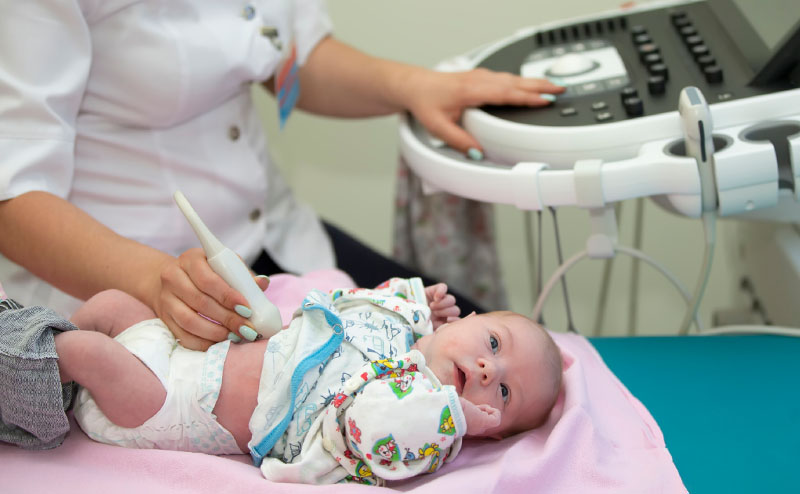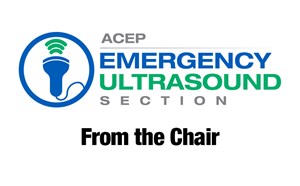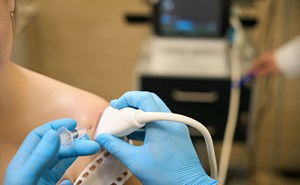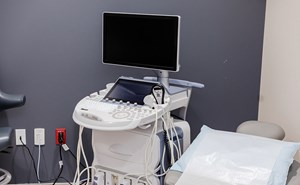
Neonatal Lung Ultrasound Safety
Anne Sung, MD
University of Michigan, Department of Emergency Medicine
Jess Koehler, MD
University of Michigan Department of Emergency Medicine
It is widely known that point-of-care ultrasound is one of the safest diagnostic imaging modalities in the Emergency Department due to the lack of ionizing radiation exposure.1 However, we do not often talk about the (albeit low) risks that ultrasound poses to our patients, particularly neonates and premature infants. This article aims to present a summary of potential harms of lung ultrasound in neonates and provide recommendations of ultrasound considerations to reduce the risk of harm and adhere to the as low as reasonably possible (ALARA) principle.
Neonatal lung ultrasound has been increasingly prevalent in emergency and critical care medicine with multiple articles showing ultrasound imaging to be an equal or even more effective diagnostic modality when compared to x-ray2. It is also quicker and less expensive without the risk of radiation exposure to neonates who are more sensitive to repeated radiation exposure.2 Point-of-care neonatal lung ultrasound is becoming more widespread and can aid in the diagnosis of pneumothorax, pleural effusion, respiratory distress syndrome, transient tachypnea of the newborn, meconium aspiration, pneumonia, and pulmonary hemorrhage.3 The risks of point-of care ultrasound include both thermal and non-thermal bioeffects with neonates and premature infants particularly vulnerable to these effects.
Ultrasonic waves lose energy as they pass through tissue and thus are converted to heat. Modern day ultrasound machines have intensities and powers that are sufficient to raise the local temperature of tissues by a few degrees Celsius.4 The probability of thermal harm is low due to the short duration of ultrasound scanning with the ultrasound probe rarely being kept in one spot for more than a few seconds at a time. In addition, movement between the beam and tissue structures (bloodstream, heart valves) minimizes the accumulation of local thermal energy4. The factors that increase the likelihood of thermal effects include frequency, output power, pulse lengths, and exposure time.5
Non-thermal bioeffects that have been described in literature as potential risks with neonatal ultrasound include lung cavitation and pulmonary capillary hemorrhage. Acoustic cavitation occurs when a gas bubble in liquid experiences variations in pressure of an acoustic wave, causing changes in size.4 This risk increases when machine settings utilize a high mechanical index.4 Pulmonary capillary hemorrhage is another non-thermal bioeffect of ultrasound that has been well studied in mice and rat models. These studies looked at B-mode, M-mode, color Doppler, and pulsed-wave Doppler.6 Neonatal swine models have also redemonstrated the induction of pulmonary capillary hemorrhage with certain ultrasound frequencies and mechanical index settings.7 Human studies have not been performed due to ethical issues of harm to neonates.
Careful consideration should be made for neonatal pulmonary ultrasound, given the potential risks, including thermal effects, acoustic cavitation, and pulmonary capillary hemorrhage. It is important for institutions to evaluate and update neonatal lung settings to mitigate risks of harm. Ultrasound equipment can demonstrate two safety indices, Thermal Index (TI) for thermal effects and Mechanical Index (MI) for non-thermal effects. The Association for Medical Ultrasound recommends a limit of MI ≤ 0.3 that should be pre-installed on all ultrasound machines for neonatal lung ultrasound.8 British Medical Ultrasound Society guidelines recommend for all neonatal scanning that TI and MI be displayed when they are greater than 0.4 so that the sonographer can be aware of when TI and MI is at a potentially unsafe, high level.5 Reducing scanning time also minimizes exposure and thus the risks. Moving the probe avoids overheating areas, and minimizing active probe contact time will decrease risks. It is also important to consider the utility of different modes of scanning since pulsed-wave doppler has the highest TI and MI values followed by color doppler when compared to B-mode.5
In summary, it is important to be aware of the potential risks of point-of-care lung ultrasound when scanning neonates, who are particularly vulnerable to the thermal and non-thermal effects. The lung is a gas containing organ that is more sensitive than other non-gas containing organs to non-thermal effects. Important considerations when performing neonatal lung ultrasound include:
- Minimizing exposure time, including active probe contact and ensuring probe movement to avoid overheating a certain area
- Scanning with the lowest power output to obtain the necessary image with B-mode having the lowest power output and pulse wave doppler having the highest
- Having a specific preset for neonatal lung ultrasound with the MI and TI ≤3 to ensure the ALARA principle is met when any practitioner is performing neonatal lung ultrasound
References
- Nemes AF, et al. Use of lung ultrasound in reducing radiation exposure in neonates with respiratory distress: a quality management project. Medicina. 2024;60(2):308.
- Kurepa D, Zaghloul N, Watkins L, Liu J. Neonatal lung ultrasound exam guidelines. J Perinatol. 2018;38:11-22.
- Miller LE, Stoller JZ, Fraga MV. Point-of-care ultrasound in the neonatal ICU. Curr Opin Pediatr. 2020;32:216-227.
- Duck F. Hazards, risks, and safety of diagnostic ultrasound. Med Eng Phys. 2008;30(10):1338-1348.
- Verma P, et al. Guidance document on ultrasound safety issues when scanning a neonate. BMUS. 2021.
- Miller DL, Dong Z, Dou C, Raghavendran K. Pulmonary capillary hemorrhage induced by different imaging modes of diagnostic ultrasound. Ultrasound Med Biol. 2017;44(5):1012-1021.
- Miller DL, Dou C, Dong Z. Lung ultrasound induction of pulmonary capillary hemorrhage in neonatal swine. Ultrasound Med Biol. 2022;48(11):2276-2291.
- Statement and Recommendations for Safety Assurance in Lung Ultrasound. The American Institute for Ultrasound in Medicine. July 16, 2023. Accessed January 27, 2024.



